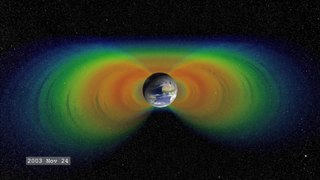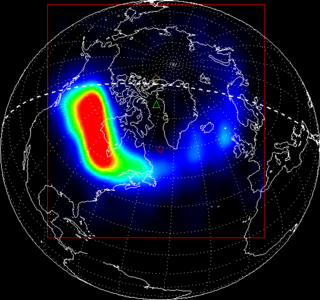Related Research Articles

The solar wind is a stream of charged particles released from the upper atmosphere of the Sun, called the corona. This plasma mostly consists of electrons, protons and alpha particles with kinetic energy between 0.5 and 10 keV. The composition of the solar wind plasma also includes a mixture of materials found in the solar plasma: trace amounts of heavy ions and atomic nuclei of elements such as C, N, O, Ne, Mg, Si, S, and Fe. There are also rarer traces of some other nuclei and isotopes such as P, Ti, Cr, and 58Ni, 60Ni, and 62Ni. Superimposed with the solar-wind plasma is the interplanetary magnetic field. The solar wind varies in density, temperature and speed over time and over solar latitude and longitude. Its particles can escape the Sun's gravity because of their high energy resulting from the high temperature of the corona, which in turn is a result of the coronal magnetic field. The boundary separating the corona from the solar wind is called the Alfvén surface.

Van Allen radiation belt is a zone of energetic charged particles, most of which originate from the solar wind, that are captured by and held around a planet by that planet's magnetosphere. Earth has two such belts, and sometimes others may be temporarily created. The belts are named after James Van Allen, who is credited with their discovery.

Space weather is a branch of space physics and aeronomy, or heliophysics, concerned with the varying conditions within the Solar System and its heliosphere. This includes the effects of the solar wind, especially on the Earth's magnetosphere, ionosphere, thermosphere, and exosphere. Though physically distinct, space weather is analogous to the terrestrial weather of Earth's atmosphere. The term "space weather" was first used in the 1950s and popularized in the 1990s. Later, it prompted research into "space climate", the large-scale and long-term patterns of space weather.

Earth's magnetic field, also known as the geomagnetic field, is the magnetic field that extends from Earth's interior out into space, where it interacts with the solar wind, a stream of charged particles emanating from the Sun. The magnetic field is generated by electric currents due to the motion of convection currents of a mixture of molten iron and nickel in Earth's outer core: these convection currents are caused by heat escaping from the core, a natural process called a geodynamo.

A geomagnetic storm, also known as a magnetic storm, is temporary disturbance of the Earth's magnetosphere caused by a solar wind shock wave.

A coronal mass ejection (CME) is a significant ejection of magnetic field and accompanying plasma mass from the Sun's corona into the heliosphere. CMEs are often associated with solar flares and other forms of solar activity, but a broadly accepted theoretical understanding of these relationships has not been established.

The atmosphere of Mars is the layer of gases surrounding Mars. It is primarily composed of carbon dioxide (95%), molecular nitrogen (2.85%), and argon (2%). It also contains trace levels of water vapor, oxygen, carbon monoxide, hydrogen, and noble gases. The atmosphere of Mars is much thinner than Earth's. The average surface pressure is only about 610 pascals (0.088 psi) which is less than 1% of the Earth's value.

The Van Allen Probes, formerly known as the Radiation Belt Storm Probes (RBSP), were two robotic spacecraft that were used to study the Van Allen radiation belts that surround Earth. NASA conducted the Van Allen Probes mission as part of the Living With a Star program. Understanding the radiation belt environment and its variability has practical applications in the areas of spacecraft operations, spacecraft system design, mission planning and astronaut safety. The probes were launched on 30 August 2012 and operated for seven years. Both spacecraft were deactivated in 2019 when they ran out of fuel. They are expected to deorbit during the 2030s.

Ionospheric storms are storms which contain varying densities of energised electrons in the ionosphere as produced from the Sun. Ionospheric storms are caused by geomagnetic storms. They are categorised into positive and negative storms, where positive storms have a high density of electrons and negative storms contain a lower density. The total electron content (TEC) is used to measure these densities, and is a key variable used in data to record and compare the intensities of ionospheric storms.

The Carrington Event was the most intense geomagnetic storm in recorded history, peaking from 1–2 September 1859 during solar cycle 10. It created strong auroral displays that were reported globally and caused sparking and even fires in multiple telegraph stations. The geomagnetic storm was most likely the result of a coronal mass ejection (CME) from the Sun colliding with Earth's magnetosphere.
The Bastille Day solar storm was a powerful solar storm on 14-16 July 2000 during the solar maximum of solar cycle 23. The storm began on the national day of France, Bastille Day. It involved a solar flare, a solar particle event, and a coronal mass ejection which caused a severe geomagnetic storm.

The Heliophysics Science Division of the Goddard Space Flight Center (NASA) conducts research on the Sun, its extended Solar System environment, and interactions of Earth, other planets, small bodies, and interstellar gas with the heliosphere. Division research also encompasses geospace—Earth's uppermost atmosphere, the ionosphere, and the magnetosphere—and the changing environmental conditions throughout the coupled heliosphere.

The solar storms of August 1972 were a historically powerful series of solar storms with intense to extreme solar flare, solar particle event, and geomagnetic storm components in early August 1972, during solar cycle 20. The storm caused widespread electric‐ and communication‐grid disturbances through large portions of North America as well as satellite disruptions. On 4 August 1972 the storm caused the accidental detonation of numerous U.S. naval mines near Haiphong, North Vietnam. The coronal mass ejection (CME)'s transit time from the Sun to the Earth is the fastest ever recorded.
Wen Li is a space physicist at Boston University. Her research interests include space plasma waves, Earth's radiation belt physics, solar-wind magnetosphere coupling, energetic particle precipitation, and Jovian magnetosphere and aurora: She is a Fellow of the American Geophysical Union.
Lynn Kistler is a physicist known for her research on the magnetosphere that protects Earth from radiation from space.
Margaret Ann ("Peggy") Shea is a space scientist known for research on the connections between cosmic radiation and Earth's magnetic field.
Mary Hudson is the Eleanor and Kelvin Smith Distinguished Professor of Physics at Dartmouth College. She is known for her research on the weather patterns that occur due to solar eruptions. She was elected a fellow of the American Geophysical Union in 1984.
Michelle F. Thomsen is space physicist known for her research on the magnetospheres of Earth, Jupiter, and Saturn.
Tamitha Skov is a space weather physicist, researcher and public speaker based in Los Angeles. She is also referred to as "Space Weather Woman" in social media, where she forecasts and analyzes space weather processes - in the heliosphere and exosphere, in addition to her conducting the same in traditional media. Skov is presently serving as a research scientist at The Aerospace Corporation and as an adjunct professor of heliophysics and space weather at Millerville University.
References
- ↑ "ORCID". orcid.org. Retrieved 2021-10-07.
- 1 2 3 "Vania Koleva Jordanova | Find Expertise". www.lanl.gov. Retrieved 2021-10-07.
- ↑ Reeves, Geoffrey D.; Koller, Josef; Tokar, Robert L.; Chen, Yue; Henderson, Michael G.; Friedel, Reiner H. (2010-01-01). The dynamic radiation environment assimilation model (DREAM) (Report). Los Alamos National Lab. (LANL), Los Alamos, NM (United States).
- ↑ "Novel Software Platform Can Predict Space Weather". Research & Development World. 2018-04-26. Retrieved 2021-10-07.
- ↑ Jordanova, V. K.; Delzanno, G. L.; Henderson, M. G.; Godinez, H. C.; Jeffery, C. A.; Lawrence, E. C.; Morley, S. K.; Moulton, J. D.; Vernon, L. J.; Woodroffe, J. R.; Brito, T. V. (2018-10-01). "Specification of the near-Earth space environment with SHIELDS". Journal of Atmospheric and Solar-Terrestrial Physics. Dynamics of the Sun-Earth System: Recent Observations and Predictions. 177: 148–159. Bibcode:2018JASTP.177..148J. doi: 10.1016/j.jastp.2017.11.006 . ISSN 1364-6826. S2CID 125573634.
- ↑ Laboratory, Los Alamos National. "Forecasting space weather | Discover Los Alamos National Laboratory". Los Alamos National Laboratory. Retrieved 2024-01-12.
- ↑ Jordanova, V. K.; Morley, S. K.; Engel, M. A.; Godinez, H. C.; Yakymenko, K.; Henderson, M. G.; Yu, Y.; Miyoshi, Y. (2023-12-15). "The RAM-SCB model and its applications to advance space weather forecasting". Advances in Space Research. COSPAR Space Weather Roadmap 2022: Scientific Research and Applications. 72 (12): 5596–5606. doi:10.1016/j.asr.2022.08.077. ISSN 0273-1177.
- ↑ "NASA Agency Honor Awards" (PDF). NASA. 2013. Retrieved October 7, 2021.
- ↑ Panjwani, Laura (2018-04-26). "Novel Software Platform Can Predict Space Weather". Research & Development World. Retrieved 2024-01-12.
- ↑ Reporter, Los Alamos (2020-10-13). "Seven Los Alamos Scientists And Engineers Honored As 2020 Laboratory Fellows". Los Alamos Reporter. Retrieved 2021-10-07.